Where is eSwatini?
About eSwatini
The Land
The People
Life and Death
Health, Energy and the Environment
Education and Work
Travel, Communication and the Media






Back to the Flags of Africa page

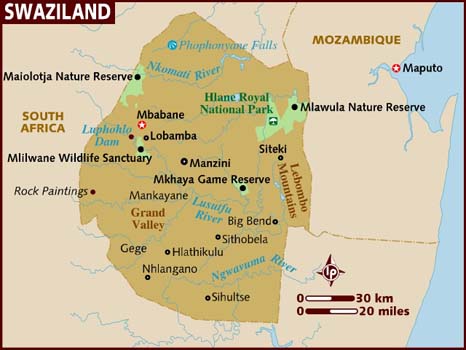


eSwatini is a small country in southern Africa.
eSwatini is a landlocked country with no coastal borders.
The land is mostly mountains and hills.
The geographical coordinates for the centre of eSwatini, also known as lines of latitude and longitude, are:-
Latitude - 26 30S
Longitude - 31 30E
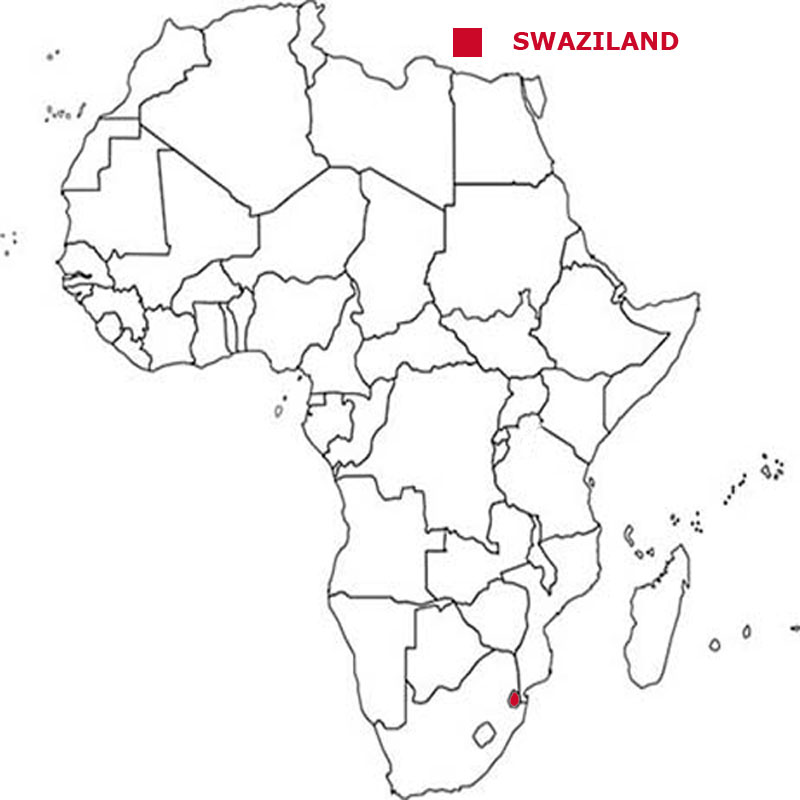

Check the weather in Manzini now. It is about 30 kms south-east of Mbabane.
This is the time in Mbabane now
 The Swazi flag is three horizontal stripes of blue, at the top, red, triple width, and blue. The red band is edged in yellow. In the centre of the red stripe is
a large black and white shield covering two spears and a staff decorated with feather tassels, all placed horizontally; Blue stands for peace and stability,
red represents past struggles and yellow the mineral resources of the country. The shield, spears, and staff symbolize protection from the country's enemies,
while the black and white of the shield are meant to portray black and white people living in peaceful coexistence.
The Swazi flag is three horizontal stripes of blue, at the top, red, triple width, and blue. The red band is edged in yellow. In the centre of the red stripe is
a large black and white shield covering two spears and a staff decorated with feather tassels, all placed horizontally; Blue stands for peace and stability,
red represents past struggles and yellow the mineral resources of the country. The shield, spears, and staff symbolize protection from the country's enemies,
while the black and white of the shield are meant to portray black and white people living in peaceful coexistence.
eSwatini is an absolute monarchy with a monarch as head of state and head of the government.
In elections everyone over the age of 18 can vote.
The currency in eSwatini is the lilangeni. eSwatini is a member of the Commonwealth.
English and siSwati are the official languages.
Hear the National Anthem
These are the anthem words
We have already written our own history of England but are asking schools in eSwatini to provide us with a detailed history of
their own country. Check how here.
![]()
![]() Back to the top
Back to the top

The total land area of eSwatini is 17,204 sq kms which is the 49th largest in Africa.
eSwatini has lakes, rivers and canals which total 160 sq kms.
eSwatini has boundaries with 2 countries
- South Africa 438 kms
- Mozambique 108 kms
eSwatini has no coastline.
The highest point in eSwatini is Emlembe at 1,862 metres.
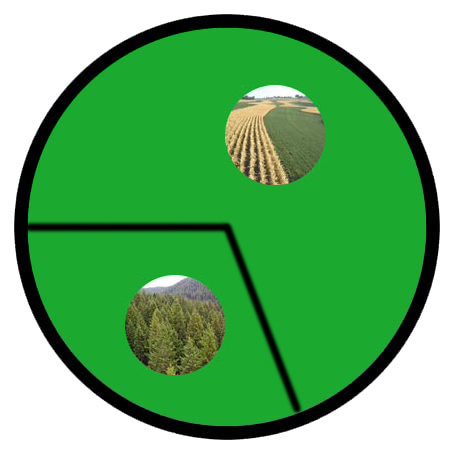

The total population of eSwatini is 1.08 million people, making it the 46th largest country in Africa by population.
Of this number 0.57 million are females and 0.51 million are males.
A person from eSwatini is called a Swazi.
To be a citizen of eSwatini, both your parents must be a citizen of eSwatini. It is not sufficient to be born in eSwatini. You have to live in eSwatini for
5 years before you can begin to apply for citizenship.
The largest five cities in eSwatini, by population are:-
- Manzini 1,024,027 people
- Mbabane 190,384
- Big Bend 185,400
- Malkerns 90,054
- Nhlangano 70,686
 Each little Owlbut is 1 person and
the big yellow rectangle is 1 sq km. After a while you can compare countries and see which ones are the most crowded. Remember it is only an average as
more people live closer together in towns and cities than in villages out in the country.
Each little Owlbut is 1 person and
the big yellow rectangle is 1 sq km. After a while you can compare countries and see which ones are the most crowded. Remember it is only an average as
more people live closer together in towns and cities than in villages out in the country.
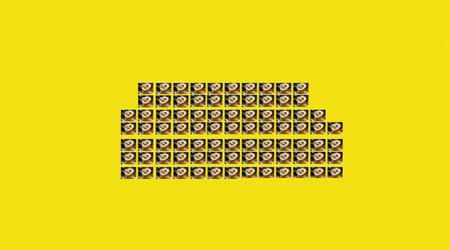
23.8% of the people live in cities or towns.

The birth rate in eSwatini is 25.8 births per 1,000 of population
The death rate in eSwatini is 10.7 deaths per 1,000 people.
Check this against the birth rate. If the death rate is higher than the birth rate then
the population will decrease unless immigrants arrive in the country.
There are 41.7 deaths of girls under 1 year per 1,000 of births and 51.4 deaths of boys.
The median age for females is 24.0 and for males is 22.2. The median age is that age which divides the population exactly in half so there are the same number
of people above the median age as below it.
We have no figures for the average age of a woman when she has her first child.
The elderly dependency ratio is 5.2. This is the number of elderly people (ages 65+) per 100 people of working age (ages 15-64).
The potential support ratio is 19.1. This is the number of working-age people (ages 15-64) per one elderly person (ages 65+). As a population ages, the potential support ratio tends to fall, meaning there are fewer potential workers to support the elderly.
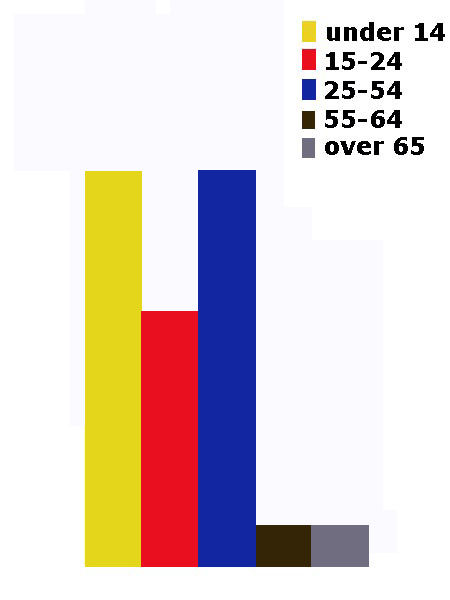
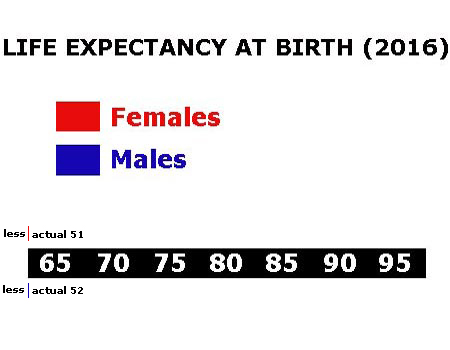

eSwatini spends 9.3% of its total income on health care.
There are 0.08 doctors per 1,000 people.
There are 2.1 hospital beds per 1,000 people.
16.5% of the population are estimated as obese.
93.6% of the urban population and 68.9% of the rural population have drinking water that is either piped into their home or they have access to a public tap, a protected borehole, well, spring or
protected rainwater collection facility.
63.1% of the urban population and 56.0% of the rural population have access to a flushing toilet that is connected to a sewer, a pit latrine (that is a
permanent hole in the ground that is looked after) or a composting toilet.
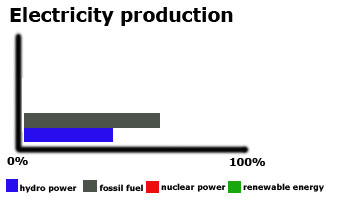
eSwatini releases 0.6 million metric tons of carbon dioxide by burning fossil fuels in the process of producing and consuming energy. This puts it as the 45th highest in Africa.

eSwatini spends 7.1% of its total income on education.
Children usually start school at age 6 in eSwatini. Primary education is for seven years until age 13 and secondary education can continue till 18. This may be followed
by further education at a university or college.
We are awaiting information about school terms in eSwatini.
87.5% of females and 87.4% of males are able to read and write by the age of 15.
47.1% of all people aged between 16 and 24 are not in work. Among females 50.1% are unemployed while with males 44.2% can't find work.
The total number of people available for work in eSwatini is 427,900.
 They work in the following sectors.
They work in the following sectors.
- Agriculture includes farming, fishing and forestry work
- Industry includes mining, manufacturing, construction and energy workers
- Services is everything else

There are 2 paved airports in eSwatini, which is the 50th highest number in Africa.
![]()
There are 301 kilometres of railways in eSwatini, the 35th longest in Africa.
![]()
There are 3,594 kilometres of roads in eSwatini, which means eSwatini is in 45th place for the most kilometres of roads in Africa.
![]()
There are 2 major national newspapers in eSwatini.
There are 995,000 mobile phone users.
3% of the people have a fixed landline.

414,724 people have access to the internet at home via any device (computer or mobile).


